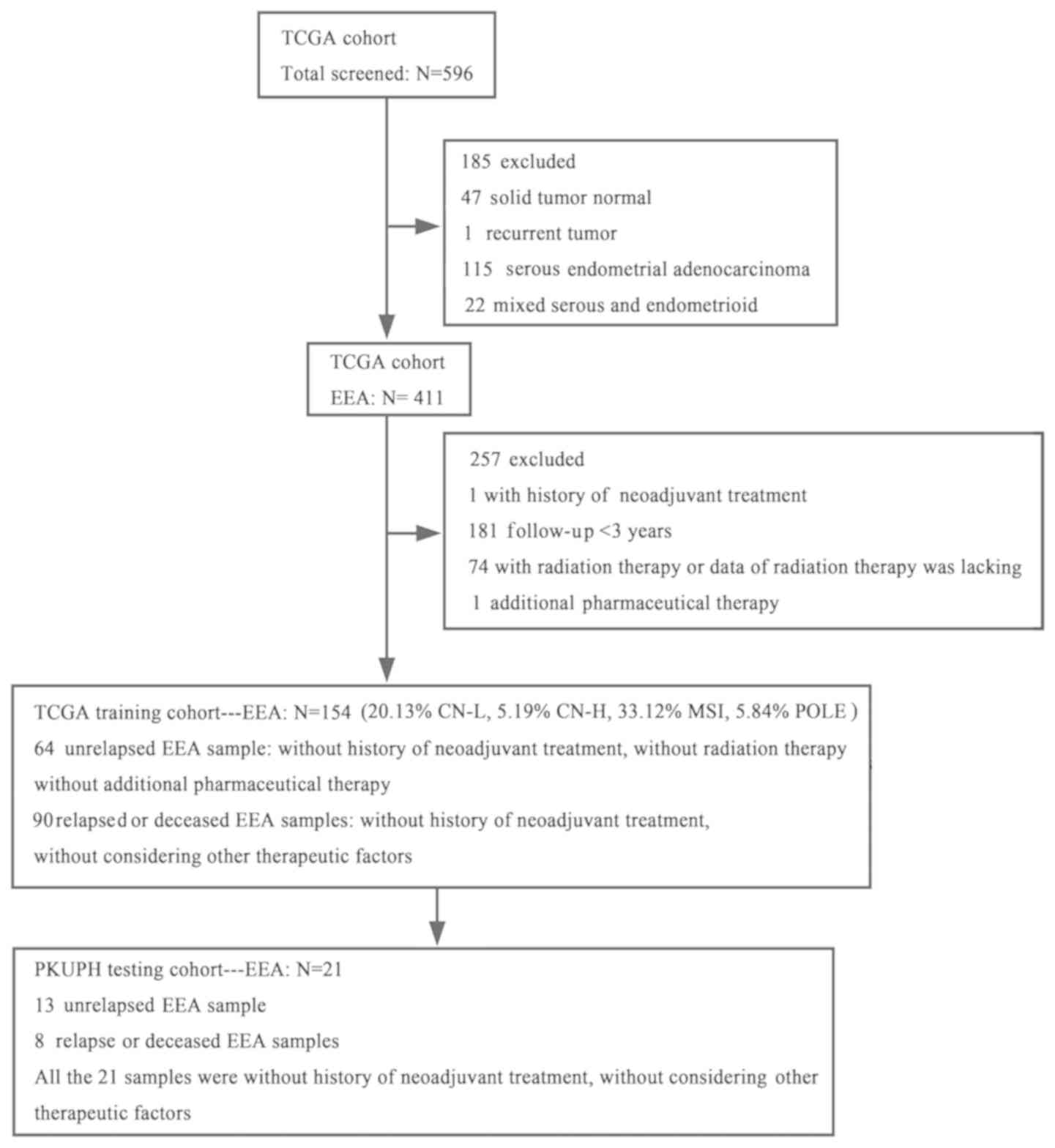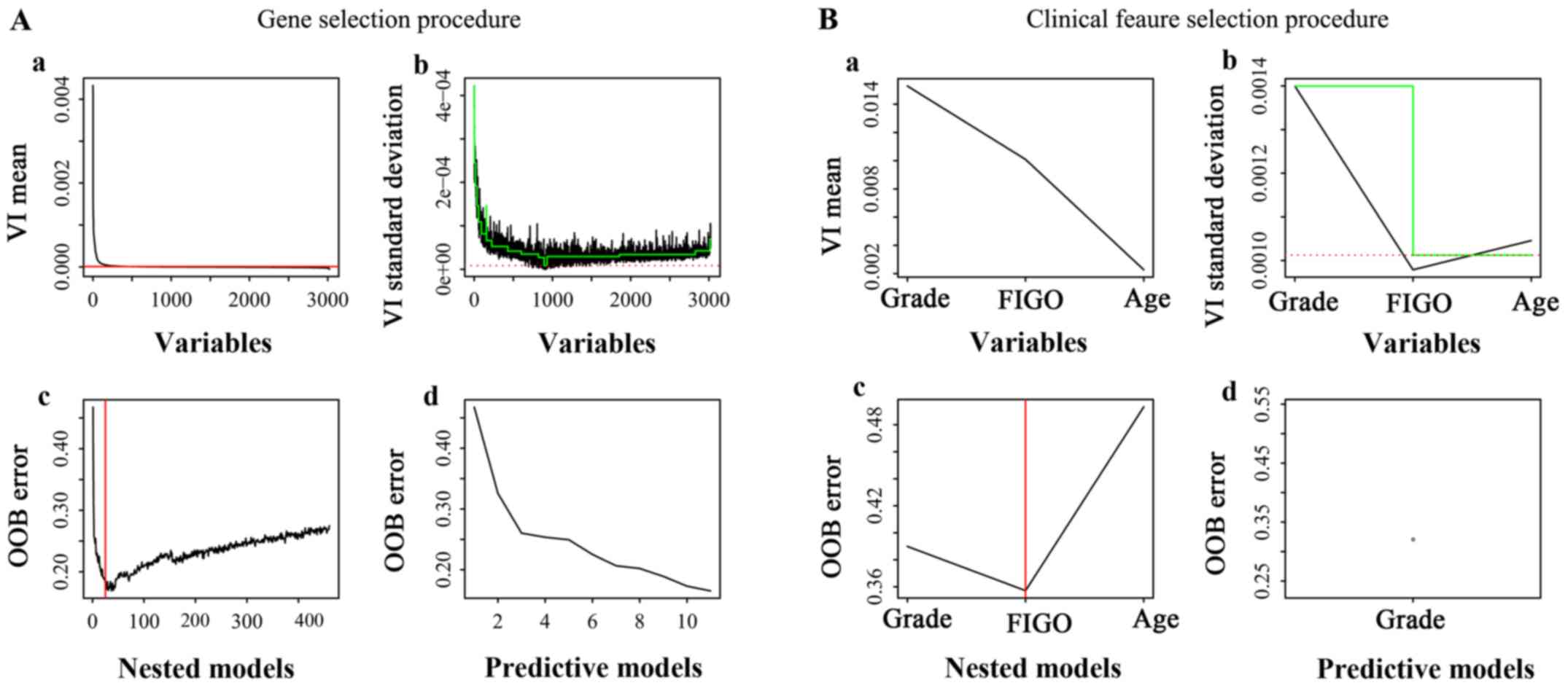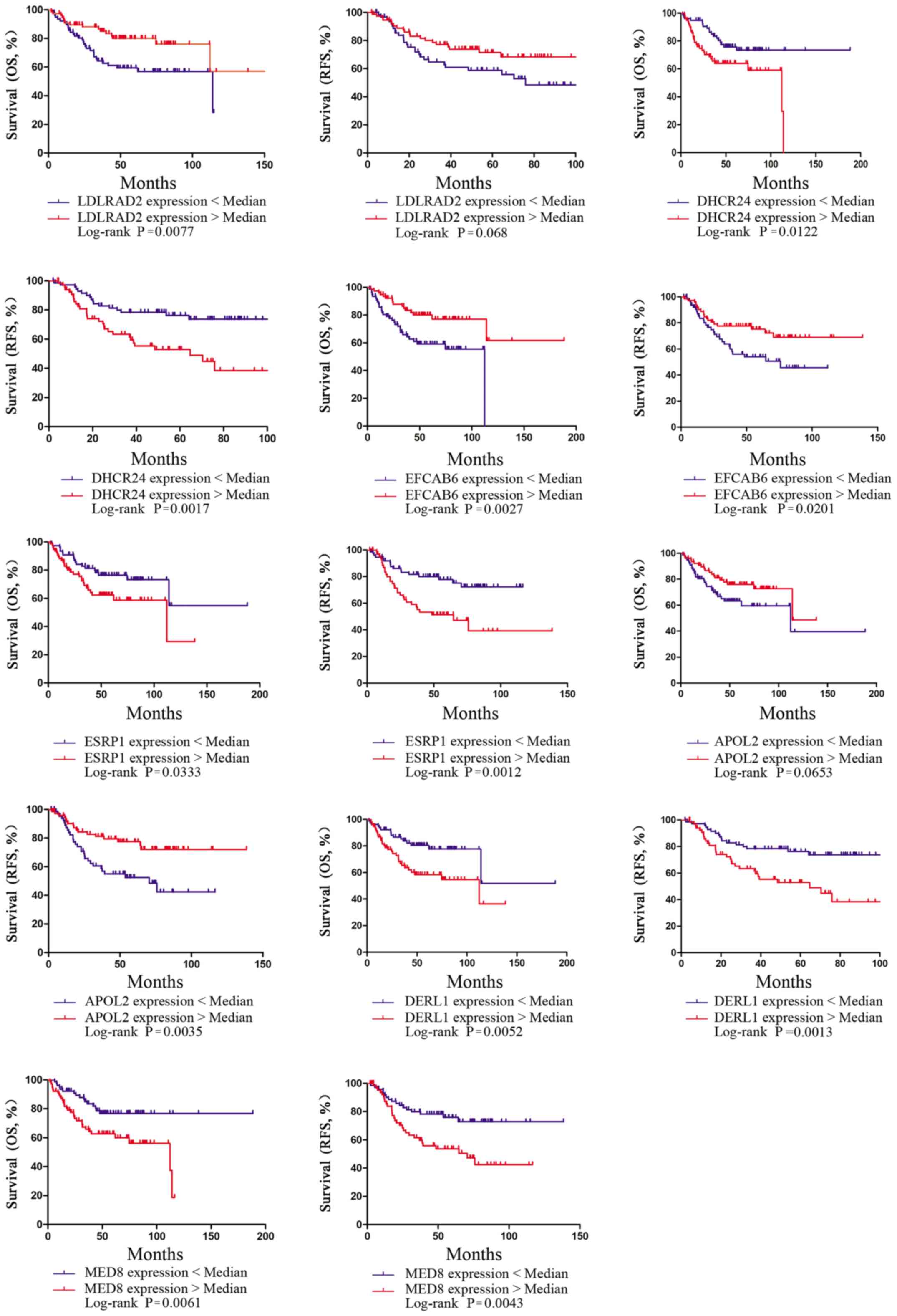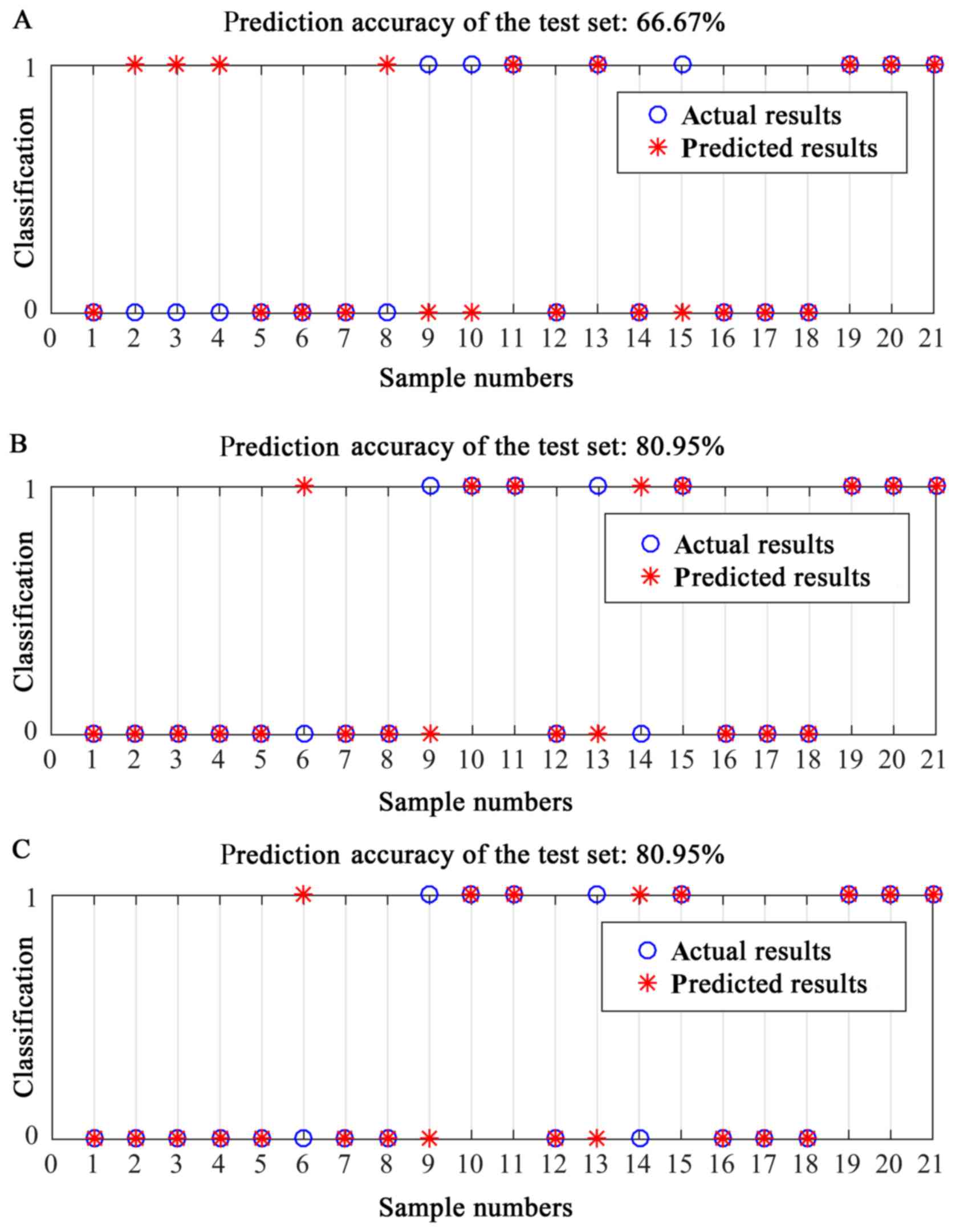|
1
|
Albertini AF, Devouassoux-Shisheboran M
and Genestie C: Pathology of endometrioid carcinoma. Bull Cancer.
99:7–12. 2012.PubMed/NCBI
|
|
2
|
Piulats JM, Guerra E, Gil-Martin M,
Roman-Canal B, Gatius S, Sanz-Pamplona R, Velasco A, Vidal A and
Matias-Guiu X: Molecular approaches for classifying endometrial
carcinoma. Gynecol Oncol. 145:200–207. 2017. View Article : Google Scholar : PubMed/NCBI
|
|
3
|
Bendifallah S, Ouldamer L, Lavoue V,
Canlorbe G, Raimond E, Coutant C, Graesslin O, Touboul C, Collinet
P, Darai E, et al: Patterns of recurrence and outcomes in
surgically treated women with endometrial cancer according to
ESMO-ESGO-ESTRO consensus conference risk groups: Results from the
FRANCOGYN study group. Gynecol Oncol. 144:107–112. 2017. View Article : Google Scholar : PubMed/NCBI
|
|
4
|
Cancer Genome Atlas Research Network, ;
Kandoth C, Schultz N, Cherniack AD, Akbani R, Liu Y, Shen H,
Robertson AG, Pashtan I, Shen R, et al: Integrated genomic
characterization of endometrial carcinoma. Nature. 497:67–73. 2013.
View Article : Google Scholar : PubMed/NCBI
|
|
5
|
Marnitz S and Kohler C: Current therapy of
patients with endometrial carcinoma. A critical review.
Strahlenther Onkol. 188:12–20. 2012. View Article : Google Scholar : PubMed/NCBI
|
|
6
|
Wright JD, Barrena Medel NI, Sehouli J,
Fujiwara K and Herzog TJ: Contemporary management of endometrial
cancer. Lancet. 379:1352–1360. 2012. View Article : Google Scholar : PubMed/NCBI
|
|
7
|
Perou CM, Sorlie T, Eisen MB, van de Rijn
M, Jeffrey SS, Rees CA, Pollack JR, Ross DT, Johnsen H, Akslen LA,
et al: Molecular portraits of human breast tumours. Nature.
406:747–752. 2000. View
Article : Google Scholar : PubMed/NCBI
|
|
8
|
Yu KH, Zhang C, Berry GJ, Altman RB, Re C,
Rubin DL and Snyder M: Predicting non-small cell lung cancer
prognosis by fully automated microscopic pathology image features.
Nat Commun. 7:124742016. View Article : Google Scholar : PubMed/NCBI
|
|
9
|
Kleppe A, Albregtsen F, Vlatkovic L,
Pradhan M, Nielsen B, Hveem TS, Askautrud HA, Kristensen GB,
Nesbakken A, Trovik J, et al: Chromatin organisation and cancer
prognosis: A pan-cancer study. Lancet Oncol. 19:356–369. 2018.
View Article : Google Scholar : PubMed/NCBI
|
|
10
|
Fernandez-Delgado M, Cernadas E, Barro S
and Amorim D: Do we need hundreds of classifiers to solve real
world classification problems? J Mach Learn Res. 15:3133–3181.
2014.
|
|
11
|
Diaz-Uriarte R and Alvarez de Andres S:
Gene selection and classification of microarray data using Random
Forest. BMC Bioinformatics. 7:32006. View Article : Google Scholar : PubMed/NCBI
|
|
12
|
Moorthy K and Mohamad MS: Random Forest
for gene selection and microarray data classification.
Bioinformation. 7:142–146. 2011. View Article : Google Scholar : PubMed/NCBI
|
|
13
|
Eshaghi A, Wottschel V, Cortese R,
Calabrese M, Sahraian MA, Thompson AJ, Alexander DC and Ciccarelli
O: Gray matter MRI differentiates neuromyelitis optica from
multiple sclerosis using Random Forest. Neurology. 87:2463–2470.
2016. View Article : Google Scholar : PubMed/NCBI
|
|
14
|
Llorens-Rico V, Lluch-Senar M and Serrano
L: Distinguishing between productive and abortive promoters using a
Random Forest classifier in Mycoplasma pneumoniae. Nucleic Acids
Res. 43:3442–3453. 2015. View Article : Google Scholar : PubMed/NCBI
|
|
15
|
Cadenas JM, Garrido MC and Martinez R:
Feature subset selection Filter-Wrapper based on low quality data.
Expert Syst Appl. 40:6241–6252. 2013. View Article : Google Scholar
|
|
16
|
Diaz-Uriarte R: GeneSrF and varSelRF: A
web-based tool and R package for gene selection and classification
using Random Forest. BMC Bioinformatics. 8:3282007. View Article : Google Scholar : PubMed/NCBI
|
|
17
|
Kwon SG, Hwang JH, Park DH, Kim TW, Kang
DG, Kang KH, Kim IS, Park HC, Na CS, Ha J and Kim CW: Associated
with litter size in ber identification of differentially expressed
genes kshire pig placenta. PLoS One. 11:e01533112016. View Article : Google Scholar : PubMed/NCBI
|
|
18
|
Pecorelli S: Revised FIGO staging for
carcinoma of the vulva, cervix, and endometrium. Int J Gynecol
Obstet. 105:103–104. 2009. View Article : Google Scholar
|
|
19
|
Shepherd JH: Revised FIGO staging for
gynaecological cancer. Br J Obstet Gynaecol. 96:889–892. 1989.
View Article : Google Scholar : PubMed/NCBI
|
|
20
|
Ouldamer L, Bendifallah S, Body G, Touboul
C, Graesslin O, Raimond E, Collinet P, Coutant C, Lavoue V, Leveque
J, et al: Predicting poor prognosis recurrence in women with
endometrial cancer: A nomogram developed by the FRANCOGYN study
group. Br J Cancer. 115:1296–1303. 2016. View Article : Google Scholar : PubMed/NCBI
|
|
21
|
Morice P, Leary A, Creutzberg C,
Abu-Rustum N and Darai E: Endometrial cancer. Lancet.
387:1094–1108. 2016. View Article : Google Scholar : PubMed/NCBI
|
|
22
|
Moreno RP, Pearse R and Rhodes A; European
Surgical Outcomes Study (EuSOS) Group of the European Society of
Intensive Care Medicine and European Society of Anaesthesiology
Trials Groups, : American society of anesthesiologists score: Still
useful after 60 years? Results of the EuSOS study. Rev Bras Ter
Intensiva. 27:105–112. 2015.(In English, Portuguese). View Article : Google Scholar : PubMed/NCBI
|
|
23
|
AlHilli MM, Mariani A, Bakkum-Gamez JN,
Dowdy SC, Weaver AL, Peethambaram PP, Keeney GL, Cliby WA and
Podratz KC: Risk-scoring models for individualized prediction of
overall survival in low-grade and high-grade endometrial cancer.
Gynecol Oncol. 133:485–493. 2014. View Article : Google Scholar : PubMed/NCBI
|
|
24
|
AlHilli MM, Podratz KC, Dowdy SC,
Bakkum-Gamez JN, Weaver AL, McGree ME, Keeney GL, Cliby WA and
Mariani A: Risk-scoring system for the individualized prediction of
lymphatic dissemination in patients with endometrioid endometrial
cancer. Gynecol Oncol. 131:103–108. 2013. View Article : Google Scholar : PubMed/NCBI
|
|
25
|
Creutzberg CL, van Putten WL, Koper PC,
Lybeert ML, Jobsen JJ, Warlam-Rodenhuis CC, De Winter KA, Lutgens
LC, van den Bergh AC, van de Steen-Banasik E, et al: Surgery and
postoperative radiotherapy versus surgery alone for patients with
stage-1 endometrial carcinoma: Multicentre randomised trial. PORTEC
study group. Post operative radiation therapy in endometrial
carcinoma. Lancet. 355:1404–1411. 2000. View Article : Google Scholar : PubMed/NCBI
|
|
26
|
Barlin JN, Zhou Q, St Clair CM, Iasonos A,
Soslow RA, Alektiar KM, Hensley ML, Leitao MM Jr, Barakat RR and
Abu-Rustum NR: Classification and regression tree (CART) analysis
of endometrial carcinoma: Seeing the forest for the trees. Gynecol
Oncol. 130:452–456. 2013. View Article : Google Scholar : PubMed/NCBI
|
|
27
|
Jordan MI and Mitchell TM: Machine
learning: Trends, perspectives, and prospects. Science.
349:255–260. 2015. View Article : Google Scholar : PubMed/NCBI
|
|
28
|
Burki TK: Predicting lung cancer prognosis
using machine learning. Lancet Oncol. 17:e4212016. View Article : Google Scholar : PubMed/NCBI
|
|
29
|
Sarica A, Cerasa A and Quattrone A: Random
Forest algorithm for the classification of neuroimaging data in
Alzheimer's disease: A systematic review. Front Aging Neurosci.
9:3292017. View Article : Google Scholar : PubMed/NCBI
|
|
30
|
Wang X, Lin P and Ho JW: Discovery of
cell-type specific DNA motif grammar in cis-regulatory elements
using Random Forest. BMC Genomics. 19:9292018. View Article : Google Scholar : PubMed/NCBI
|
|
31
|
Taherzadeh G, Zhou Y, Liew AW and Yang Y:
Structure-based prediction of protein-peptide binding regions using
Random Forest. Bioinformatics. 34:477–484. 2018. View Article : Google Scholar : PubMed/NCBI
|
|
32
|
Dong W, Guan FF, Zhang X, Gao S, Liu N,
Chen W, Zhang LF and Lu D: Dhcr24 activates the PI3K/Akt/HKII
pathway and protects against dilated cardiomyopathy in mice. Animal
Model Exp Med. 1:40–52. 2018. View Article : Google Scholar : PubMed/NCBI
|
|
33
|
Dai M, Zhu XL, Liu F, Xu QY, Ge QL, Jiang
SH, Yang XM, Li J, Wang YH, Wu QK, et al: Cholesterol synthetase
DHCR24 induced by insulin aggravates cancer invasion and
progesterone resistance in endometrial carcinoma. Sci Rep.
7:414042017. View Article : Google Scholar : PubMed/NCBI
|
|
34
|
Liu XP, Yin XH, Meng XY, Yan XH, Cao Y,
Zeng XT and Wang XH: DHCR24 predicts poor clinicopathological
features of patients with bladder cancer: A STROBE-compliant study.
Medicine. 97:e118302018. View Article : Google Scholar : PubMed/NCBI
|
|
35
|
Li L, Qi L, Qu T, Liu C, Cao L, Huang Q,
Song W, Yang L, Qi H, Wang Y, et al: Epithelial splicing regulatory
protein 1 inhibits the invasion and metastasis of lung
adenocarcinoma. Am J Pathol. 188:1882–1894. 2018. View Article : Google Scholar : PubMed/NCBI
|
|
36
|
Chen L, Yao Y, Sun L, Zhou J, Miao M, Luo
S, Deng G, Li J, Wang J and Tang J: Snail driving alternative
splicing of CD44 by ESRP1 enhances invasion and migration in
epithelial ovarian cancer. Cell Physiol Biochem. 43:2489–2504.
2017. View Article : Google Scholar : PubMed/NCBI
|
|
37
|
Fagoonee S, Picco G, Orso F, Arrigoni A,
Longo DL, Forni M, Scarfo I, Cassenti A, Piva R, Cassoni P, et al:
The RNA-binding protein ESRP1 promotes human colorectal cancer
progression. Oncotarget. 8:10007–10024. 2017. View Article : Google Scholar : PubMed/NCBI
|
|
38
|
Druĭ AE, Tsaur GA, Popov AM, Tuponogov SN,
Shorikov EV, Tsvirenko SV, Savel'ev LI and Fechina LG: The TH,
ELAVL4 and GD2 gene expression as diagnostic markers of bone marrow
lesions in patients with neuroblastoma. Vopr Onkol. 58:514–520.
2012.(In Russian). PubMed/NCBI
|
|
39
|
Stawski R, Piaskowski S,
Stoczynska-Fidelus E, Wozniak K, Bienkowski M, Zakrzewska M,
Witusik-Perkowska M, Jaskolski DJ, Och W, Papierz W, et al: Reduced
expression of ELAVL4 in male meningioma patients. Brain Tumor
Pathol. 30:160–166. 2013. View Article : Google Scholar : PubMed/NCBI
|
|
40
|
Davidson B, Stavnes HT, Holth A, Chen X,
Yang Y, Shih IM and Wang TL: Gene expression signatures
differentiate ovarian/peritoneal serous carcinoma from breast
carcinoma in effusions. J Cell Mol Med. 15:535–544. 2011.
View Article : Google Scholar : PubMed/NCBI
|
|
41
|
Klopfleisch R, Klose P and Gruber AD: The
combined expression pattern of BMP2, LTBP4, and DERL1 discriminates
malignant from benign canine mammary tumors. Vet Pathol.
47:446–454. 2010. View Article : Google Scholar : PubMed/NCBI
|
|
42
|
Hirasawa A, Makita K, Akahane T, Yokota M,
Yamagami W, Banno K, Susumu N and Aoki D: Hypertriglyceridemia is
frequent in endometrial cancer survivors. Jpn J Clin Oncol.
43:1087–1092. 2013. View Article : Google Scholar : PubMed/NCBI
|
|
43
|
Trousil S, Lee P, Pinato DJ, Ellis JK,
Dina R, Aboagye EO, Keun HC and Sharma R: Alterations of choline
phospholipid metabolism in endometrial cancer are caused by choline
kinase alpha overexpression and a hyperactivated deacylation
pathway. Cancer Res. 74:6867–6877. 2014. View Article : Google Scholar : PubMed/NCBI
|
|
44
|
Javorhazy A, Farkas N, Beothe T, Pusztai
C, Szanto A and Kovacs G: Lack of TMEM27 expression is associated
with postoperative progression of clinically localized conventional
renal cell carcinoma. J Cancer Res Clin Oncol. 142:1947–1953. 2016.
View Article : Google Scholar : PubMed/NCBI
|
|
45
|
Abu-Rustum NR, Zhou Q, Gomez JD, Alektiar
KM, Hensley ML, Soslow RA, Levine DA, Chi DS, Barakat RR and
Iasonos A: A nomogram for predicting overall survival of women with
endometrial cancer following primary therapy: Toward improving
individualized cancer care. Gynecol Oncol. 116:399–403. 2010.
View Article : Google Scholar : PubMed/NCBI
|
|
46
|
Creutzberg CL, van Stiphout RG, Nout RA,
Lutgens LC, Jurgenliemk-Schulz IM, Jobsen JJ, Smit VT and Lambin P:
Nomograms for prediction of outcome with or without adjuvant
radiation therapy for patients with endometrial cancer: A pooled
analysis of PORTEC-1 and PORTEC-2 trials. Int J Radiat Oncol Biol
Phys. 91:530–539. 2015. View Article : Google Scholar : PubMed/NCBI
|


















